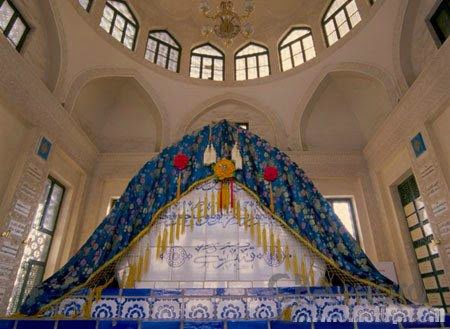Five kilometers
(3.1 miles) northeast of Kashgar, an ancient Islamic building nestles among
poplar trees. With glazed tiles shining in the sun, its tower points to the
azure sky. It is the ancient Islamic
building called Abakh Khoja Tomb that lies hidden among beautiful scenery. The
tomb served as the family tomb of Abakh Khoja, the powerful ruler of Kashgar in
the 17th century who was revered as a prophet and second only to Mohammed. It was first built
in 1640 and contained 72 members belonging 5 generations of the family. Emperor
Qianlong's favored concubine-Xianggei(fragrant Concubine) was also said to be
buried here.
In China Beijing Beijing
Entering the main
gate, visitors will see a big rectangle-shaped courtyard, which contains a gate
tower, higher and lower worship walls, Doctrine-Teaching Hall, an orchard and
the main tomb chamber. The gate tower is small while very brilliant. Close to
the gate tower is a small mosque, which is used as a daily service hall for the
local muslins.
A larger church in
the west part of the cemetery is where many important religious activities take
place. Muslims from South
Xinjiang Province
Built from 1640,
the tomb covers an area of about five acres. Just inside the gate is a large
rectangular courtyard made up of a gate tower, worship walls, Doctrine-Teaching
Hall, and tomb chamber.
The tomb chamber
is the main building in the group, the most magnificent mausoleum in Xinjiang.
Its base is rectangular with a huge brick column at each corner. The dome of
the main chamber is semicircular with a diameter of 17 meters (55.7 feet). At
its top is a circular edifice with a crescent. The chamber is 36 meters (118
feet) long and 27 meters (88.5 feet) high. The tomb faces south with a
staircase leading to its top. The gate to the tomb is decorated with exquisite
plaster patterns. The walls and the dome are covered with green glazed tiles.
Ceramic tiles with colored patterns and Arabic words dot the four sides as
well. Fifty-eight tombs provide resting places for five generations of 72
people in the Abakh Khoja family. All coffins are covered with gorgeous silk
and satin. The stone coffin of Xiang Fei lying inconspicuously in the southeast
corner attracts many visitors.
For more
information, please visit www.top-chinatour.com




No comments:
Post a Comment